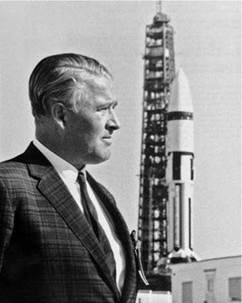Wheeling Up the "Big Gun"
Although Mueller was not ready to suggest sending humans to Mars, the team that had developed the integrated plan under his guidance had also prepared a scenario in which the hardware systems developed through the integrated plan could be used for a Mars landing in 1986. Paine heard a briefing on this scenario on July 19, as he waited in Houston for the next day’s landing on the Moon. This briefing likely solidified Paine’s decision to confront the STG with a technically plausible approach to a human Mars mission, one that would build upon the plan he had already selected as NASA’s preference for the 1970s.
Then, on July 23, Paine decided to “wheel up NASA’s big gun,” the charismatic director of its Marshall Space Flight Center, Wernher von Braun, to take the lead in preparing the STG presentation. Von Braun was a well – known spokesman for pushing the frontiers of space exploration. After being brought to the United States from Germany at the end of World War II, he had readily adapted to his new country and had become widely known as a space visionary through his appearances on television, magazine articles, and in numerous talks around the country. Von Braun had long been thinking about the technical requirements for sending humans to Mars, and after being exposed to Mueller’s thinking in May 1969 had also directed his center’s Future Projects Office to develop an approach to using the integrated plan hardware for a two-year mission to Mars. He was thus well prepared to respond to Paine’s request that he prepare a presentation based on the earliest feasible date for an initial Mars mission.28
|
Wernher von Braun with a Saturn 1B booster on its launch pad in the background. (NASA photograph) |
Von Braun was later to raise some reservations about his role in presenting the Mars mission proposal to the STG. In a 1970 interview, he suggested that “I have never in the last two or three years strongly promoted a manned Mars project. I have supplied some data on how one would mount a Mars project, a manned Mars visit with today’s technology, but I in fact have always actively advocated not to pursue such a thing at this point in time. People. . . have tried to cast me in the image in the last few years as the Mars or bust guy in this agency, which I am definitely not.” He continued, in a not very veiled rebuke to Tom Paine, that “I, for one, have always felt that it would be a good idea to read the signs of the times and respond to what the country really wants, rather than try to cram a bill of goodies down somebody’s throat for which the time is not ripe or ready.” He wondered “how bullish you can get in a bear market,” adding that “there may be too many people in NASA who at the moment are waiting for a miracle, just waiting for another man on a white horse to come and offer us another planet.” But the political environment “is more difficult and more demanding than it was with that carte blanche from Kennedy,” since “we have turned from a visionary society to an introspective society in the last ten years.” As his biographer notes, while von Braun may have had serious reservations about being used to present an ambitious Mars plan to the STG, “he certainly kept quiet about them in 1969.”29
Agnew on July 25 sent a memorandum to the STG members and observers announcing an August 4 meeting of the STG. Paine had decided to have the meeting at NASA so von Braun could use the space agency’s elaborate three-screen projection system for his presentation. Agnew’s memo said that as an important item of business “the recommendations of the Staff Directors for the Principals will be discussed.” But first, NASA would make a presentation “on a proposed major new program goal which would focus United States space efforts during the coming decade.”30











